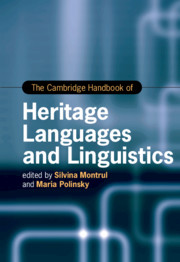Book contents
- The Cambridge Handbook of Heritage Languages and Linguistics
- Cambridge Handbooks In Language And Linguistics
- The Cambridge Handbook of Heritage Languages and Linguistics
- Copyright page
- Dedication
- Contents
- Figures and Tables
- Contributors
- Acknowledgments
- Introduction
- Part I Heritage Languages around the World
- Part II Research Approaches to Heritage Languages
- Part III Grammatical Aspects of Heritage Languages
- 23 Phonetics and Phonology of Heritage Languages
- 24 Morphology of Heritage Languages
- 25 Syntax of Heritage Languages
- 26 Semantics of Heritage Languages
- 27 Discourse and Information Structure in Heritage Languages
- 28 Pragmatics in Heritage Languages
- Part IV Heritage Language Education
- Index
- References
25 - Syntax of Heritage Languages
from Part III - Grammatical Aspects of Heritage Languages
Published online by Cambridge University Press: 04 November 2021
- The Cambridge Handbook of Heritage Languages and Linguistics
- Cambridge Handbooks In Language And Linguistics
- The Cambridge Handbook of Heritage Languages and Linguistics
- Copyright page
- Dedication
- Contents
- Figures and Tables
- Contributors
- Acknowledgments
- Introduction
- Part I Heritage Languages around the World
- Part II Research Approaches to Heritage Languages
- Part III Grammatical Aspects of Heritage Languages
- 23 Phonetics and Phonology of Heritage Languages
- 24 Morphology of Heritage Languages
- 25 Syntax of Heritage Languages
- 26 Semantics of Heritage Languages
- 27 Discourse and Information Structure in Heritage Languages
- 28 Pragmatics in Heritage Languages
- Part IV Heritage Language Education
- Index
- References
Summary
In research on heritage speakers, it is often observed that areas of core syntax tend to be resilient and resemble the relevant baseline. This chapter discusses this generalization and provides examples of areas that tend to be resilient and areas that are vulnerable. Research into the syntax of heritage speakers has tended to focus on certain areas, such as argument structure and the representation of null arguments, meaning that a lot of grammatical domains have not been sufficiently explored. This chapter nevertheless tries to summarize the main findings and outline important methodological and theoretical issues that any work on heritage syntax needs to consider carefully. Examples of the latter include the question of what the appropriate baseline for comparison is, and how to adequately separate morphology and syntax. Empirically, the chapter will consider lexical categories, passives, and verb second as examples of relatively resilient areas of syntactic representations. In terms of areas that are more vulnerable, it will look at word order, long-distance dependencies, and discontinuous dependencies.
- Type
- Chapter
- Information
- The Cambridge Handbook of Heritage Languages and Linguistics , pp. 644 - 667Publisher: Cambridge University PressPrint publication year: 2021
References
- 4
- Cited by



